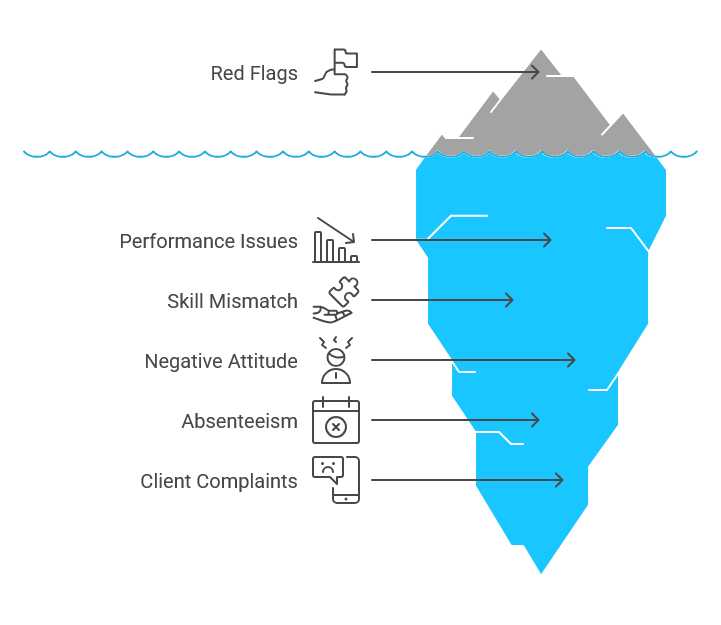Don’t have the time to read?Listen here instead or save to your Spotify playlist. |
The wrong hire costs you time, money, and momentum. Maybe they looked sharp on paper. Maybe they said all the right things. But once they’re in the seat? Missed deadlines. Botched handoffs. Tension. Burnout. You need to avoid the cost of a bad hire.
“The truth? Most bad hires don’t look like bad hires at first. They sail through interviews. Their résumé checks out. But once they’re on the job, it’s clear: they’re not delivering,” said Ruffy Galang, CEO and Co-Founder Remote Employee. “And every day you wait to make a move is costing you more.”
In this guide, we walk you through the real cost of a hiring mistake—from dollars lost to culture damage—and how to spot red flags early.
What Counts as a Bad Hire? What Are the Different Ways a Bad Hire Can Cost You?
A bad hire is someone who slows your team down, drains your resources, and chips away at your culture. Whether they’re missing deadlines, clashing with coworkers, or just not aligned with your values, the impact spreads fast—and deep.
The Real Price Tag
Think the damage stops at a salary? Think again. Between recruiting, onboarding, training, and lost productivity, the average cost of a bad hire runs $17,000. Some estimates push the total damage well into six figures, especially if legal issues come into play.
The Intangible Fallout
It’s not just the budget. It’s the burnout. A bad hire creates ripple effects: demoralized team members, missed client deadlines, reputation hits, and the frustration of redoing subpar work. Projects stall. Tensions rise. The energy shifts—and not in a good way.
How Can You Tell if You Made a Bad Hire?
Not every rough start means you hired the wrong person. But if the red flags keep coming after the ramp-up period, it’s time to face the facts.
Bad hiring decisions account for 80% of employee turnover—and the longer you ignore the signs, the more it’ll cost you. Catch the warning signals early, and you can take action before the damage spreads.
Red Flags You Shouldn’t Ignore
🚫 Performance is flat—or worse.
They’re not hitting KPIs. Work is sloppy. Deadlines keep getting missed. If results aren’t improving with time, that’s a problem you can’t afford to ignore.
🚫 Skills don’t match the résumé.
If they talked a big game but can’t deliver what they claimed in the interview, you’ve got a misalignment that’s costing you time and credibility.
🚫 The attitude is off.
Tension, blame-shifting, constant criticism, or refusing to adapt to your culture—these are red alerts that the fit isn’t just off, it’s an issue.
🚫 They’re absent more than they’re present.
Late starts, ghosted meetings, and “sick days” every week? Reliability isn’t optional.
🚫 Client feedback is slipping.
If complaints go up every time this person touches a project, you’re paying for their mistakes with your reputation.
Not Sure Yet? Look at the Pattern
One issue might just be a bad week. But repeated problems—even after support, training, and feedback—point to something deeper.
If you’re seeing the same mistakes, the same excuses, and the same disruption, you’re dealing with the true cost of a bad hire that’s dragging your business backward.

How You Can Avoid the Cost of Hiring the Wrong Person
Most bad hires don’t look bad on day one. They breeze through interviews, check all the boxes, and seem like a safe bet—until they quietly derail productivity. And when disengagement sets in, the damage isn’t small.
In fact, disengaged employees cost U.S. businesses between $450 billion and $550 billion every year. If your hiring process relies on gut instinct and surface-level answers, you’re not just guessing—you’re gambling. Here’s how to stop that.
1. Ditch the Guesswork. Define the Must-Haves.
Split every role into two buckets:
- Must-have skills: No training provided. If they don’t walk in with them, they’re not your hire.
- Nice-to-have skills: You’ll train here—but some baseline knowledge is a bonus.
Be crystal clear in the job description. Be specific in the interview. Ask candidates to prove what they know—not talk around it.
2. Study Your Last Mistake
Already had a hire go south? Don’t just move on. Break it down.
What went wrong? Was it skills? Speed? Attitude? Missed deadlines? Now turn those weak spots into filters for your next round. Ask targeted questions. Build role-specific tests.
3. Fix the Process, Not Just the Person
If your hires keep falling short, it’s not just about who you picked—it’s how you picked them.
- Did you rush the search?
- Skip checking references?
- Write a generic job post that didn’t screen for role-fit?
Fix that first. Then look at onboarding. Make sure new hires are trained well enough to actually succeed.
Stop Paying for Bad Hires—Start Hiring with Certainty
Get pre-vetted talent ready to deliver. No guesswork, no wasted time.
4. Don’t Let Problems Fester
If you see red flags, act fast. Start the conversation early. Be direct about what’s not working—and what has to change.
When you give someone clear feedback and a real shot to improve, you either get a stronger employee or a clear reason to cut ties. Either way, you move forward.
5. When the Role Doesn’t Fit the Person
If they’re trying hard but still missing the mark, the problem might be the seat—not the person. Before you cut ties, ask yourself:
- Are they failing because of skill gaps or because they’re in the wrong role entirely?
- Do they show strong effort, integrity, and coachability?
If the answer is yes, consider reshuffling. You might salvage a solid team player by putting them where they can actually thrive.
| Learn more about how a BPO can help you find the best-fit hires: |
6. When the Person Doesn’t Fit the Business
Now if the issue is deeper—bad attitude, poor communication, or no work ethic—stop wasting time. That’s not fixable with training or title changes. Don’t wait for things to spiral. Make a clean break and protect your team’s momentum.
Keep a short list of solid candidates on deck from your last round. You don’t have to reach out right away, but having a backup plan means you’re never stuck scrambling if you decide to make a switch.
7. Upgrade Your Process, Not Just Your Team
A bad hire is rarely a fluke. If this keeps happening, your hiring process needs work.
Start with the job description. Was it accurate? Too vague? Then look at how you evaluated fit—were you testing for skills or relying on personality? Patch the holes now so you don’t repeat them next time.
So, what’s the fix? You can overhaul your process, refine your screening, and hope for better outcomes—or you can skip the trial and error altogether.
You Don’t Need to Handle the True Cost of a Bad Hire—You Need the Right People, Right Now
One wrong hire doesn’t just drain your budget—it wrecks morale, slows down projects, and forces your top performers to pick up the slack. You can’t afford to keep guessing.
Remote Employee helps you hire with confidence.
We pre-vet every candidate so you’re not wasting time—or money—on someone who can’t deliver. You get control over who joins your team. We handle the sourcing, screening, and onboarding.
You skip the hiring risk and process. You keep your team moving.
Ready to stop paying for hiring mistakes? Let’s build your A-team.
Contact us today to get started.









